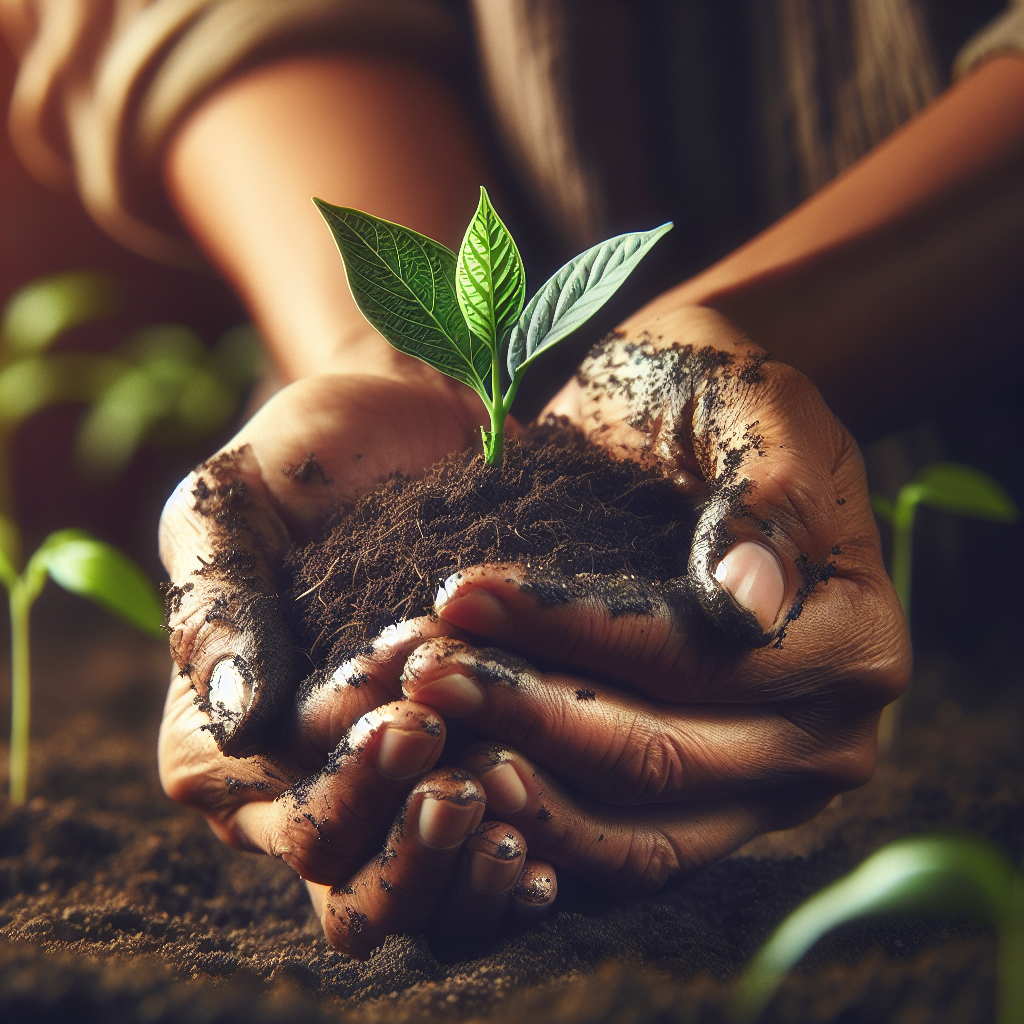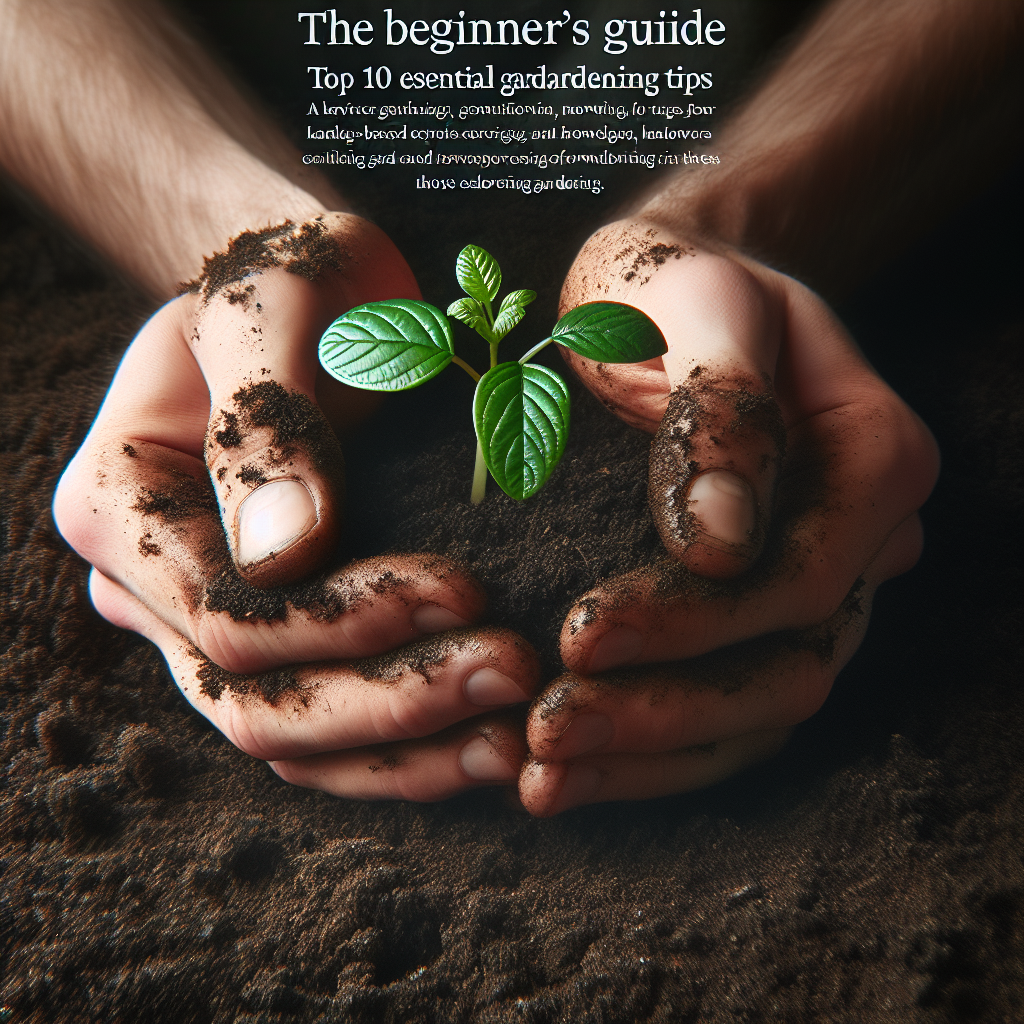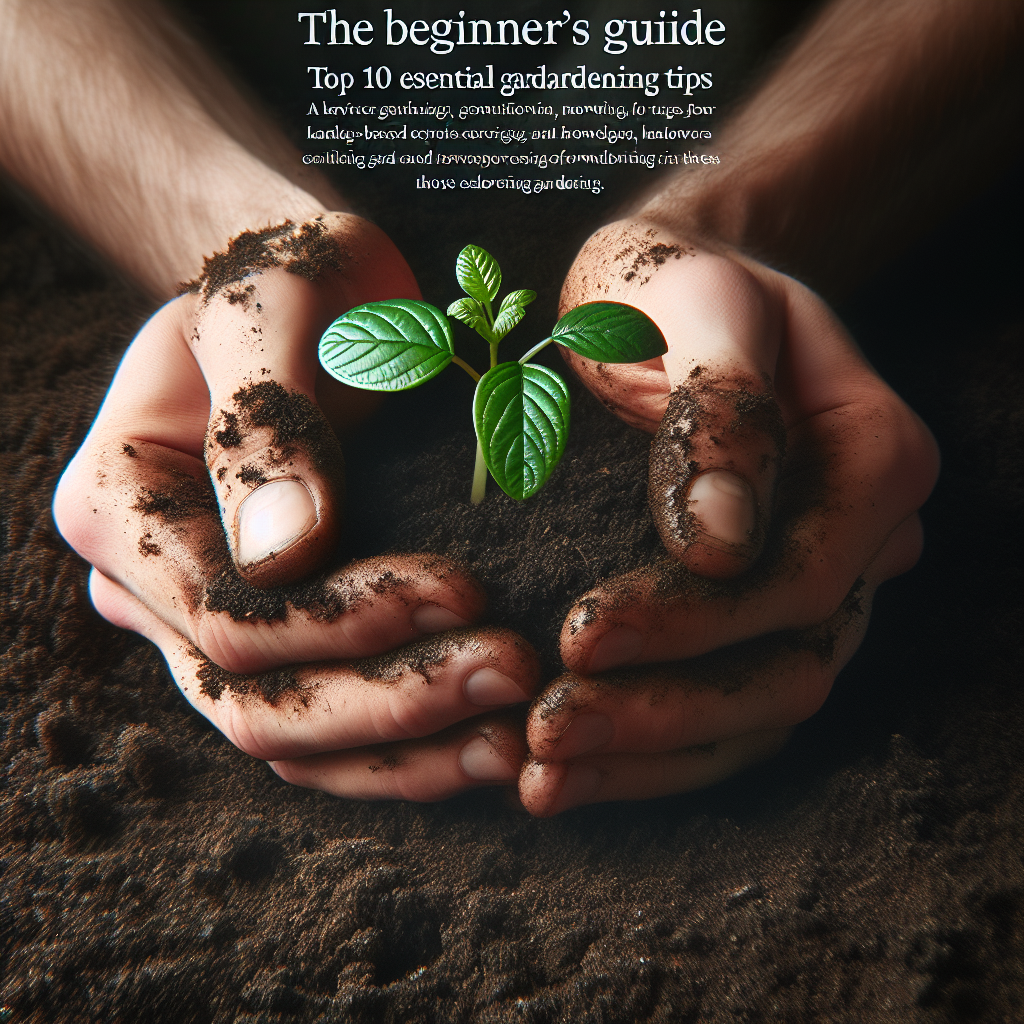Whether you’re stepping into the world of gardening for the first time or looking to improve your green thumb skills, this article is here to help. In this guide, you’ll find the top 10 essential gardening tips tailored specifically for beginners. From choosing the right plants to mastering watering techniques and understanding the importance of sunlight, these tips will set you on the path to creating a thriving and beautiful garden in no time. So grab your gardening gloves and get ready to transform your outdoor space into a lush oasis with these expert-approved tips.
Choosing the Right Location
Consider sunlight
When choosing a location for your garden, one of the most crucial factors to consider is sunlight. Most plants require at least six hours of direct sunlight each day to thrive. Take note of the areas in your yard that receive the most sunlight and plan your garden accordingly. Keep in mind that some plants, like vegetables, may need more sunlight than others, so choose the sunniest spots for them.
Evaluate soil quality
The quality of your soil is another essential aspect to consider when selecting a garden location. Conduct a soil test to determine its pH level and nutrient content. This will help you understand what you need to do to improve your soil to ensure healthy plant growth. Sandy soil often drains quickly and may require additional amendments, while clay soil can become waterlogged. Understanding your soil’s composition will guide your planting decisions.
Ensure proper drainage
Proper drainage is crucial for the health of your plants. When choosing a garden location, make sure the area has good drainage to prevent water from pooling around the roots of your plants. If your garden is located in an area with poor drainage, you may need to amend the soil or consider raised bed gardening to ensure better water flow. Remember, excess water can lead to root rot and other plant problems, so ensuring proper drainage is vital.
Starting with the Right Plants
Research suitable plant varieties
Before you start your garden, it’s essential to research the suitable plant varieties for your region and climate. Different plants have different environmental requirements, such as temperature, humidity, and soil conditions. By choosing plants that are well-suited to your area, you increase the chances of successful growth and a thriving garden. Look for plant varieties that are known to perform well in your specific growing zone.
Consider seasonal preferences
Consider the seasonal preferences of the plants you want to grow. Some plants thrive in cooler temperatures, while others prefer warmer climates. Understanding the optimal planting times for each plant will help you plan your garden effectively. Consider using a planting calendar or consulting with local gardening experts to ensure you plant your crops at the right time for optimal growth.
Choose disease-resistant plants
Another important factor to consider when selecting plants for your garden is their resistance to common diseases and pests. Disease-resistant plants are more likely to survive and thrive, reducing the need for extensive pesticide use. Look for plant varieties that are known for their disease resistance to minimize the risk of plant loss and maximize your chances of a healthy garden.

Preparing the Soil
Remove weeds and debris
Before you start planting, it’s essential to clear your garden area of any weeds and debris. Weeds can compete with your plants for nutrients and water, hindering their growth. Remove any large rocks, roots, or other debris that may impede the development of your plants.
Amend soil with organic matter
To ensure the fertility and nutrient content of your soil, it’s beneficial to amend it with organic matter. Organic matter, such as compost, adds essential nutrients to the soil, improves its structure, and promotes healthy microbial activity. Incorporate organic matter into the soil by mixing it thoroughly before planting. This will provide a nutrient-rich foundation for your plants to grow.
Test soil pH levels
Knowing your soil’s pH level is crucial for proper plant growth. Most plants prefer a slightly acidic to neutral pH range. Conduct a soil pH test using a home testing kit or by sending a sample to a professional lab. If the pH level is too high or too low, you can adjust it by adding lime to raise the pH or sulfur and peat moss to lower it. Maintaining the correct pH level will help your plants absorb nutrients effectively and thrive in your garden.
Providing Adequate Watering
Learn plant-specific watering needs
Different plants have different watering needs, so it’s important to learn the specific requirements of the plants in your garden. Some plants, like succulents, prefer dry conditions with infrequent watering, while others, such as vegetables, require consistent moisture. Understanding the optimal watering needs of each plant will prevent overwatering or underwatering, both of which can harm your plants.
Use a watering schedule
Establishing a watering schedule can help you maintain consistent moisture levels for your plants. Watering in the early morning is often recommended, as it allows the plants to absorb the moisture before the heat of the day. Avoid watering in the evening, as this can promote fungal diseases. Adjust your watering schedule based on weather conditions, plant type, and soil moisture levels.
Water early in the day
Watering your plants early in the day allows them to absorb the moisture they need before the sun evaporates it. This promotes healthy root growth and reduces the risk of fungal diseases. Avoid watering during the hottest part of the day, as the water may quickly evaporate or scorch the leaves. Watering early in the morning ensures that your plants have sufficient moisture to withstand the heat of the day.

Using Mulch for Weed Control
Apply a layer of mulch around plants
Mulching is an effective way to control weeds and conserve moisture in your garden. Apply a layer of mulch, such as wood chips, straw, or shredded leaves, around your plants. Mulch creates a barrier that prevents weed seeds from germinating and competing with your plants for resources. It also helps retain moisture in the soil, reducing the frequency of watering.
Choose the right mulch type
When selecting mulch, consider the specific needs of your plants. Some mulches, like wood chips, break down slowly and are better suited for perennial beds, while others, like straw, decompose more quickly and are ideal for vegetable gardens. Avoid using mulch that may introduce weed seeds or diseases to your garden. Research the pros and cons of different mulch types to determine which is best for your specific garden.
Top up mulch periodically
Mulch gradually decomposes over time, so it’s important to periodically top it up to maintain its weed control and moisture retention benefits. As the mulch layer thins out, add new mulch to maintain a layer that’s about 2-3 inches thick. This will ensure effective weed suppression and moisture conservation throughout the growing season.
Practicing Proper Planting Techniques
Dig the right size hole
When planting new plants, it’s important to dig the right size hole to accommodate their root systems. A hole that is too small can constrict the roots and hinder plant growth, while a hole that is too large may cause the plant to become unstable. Follow the planting instructions for each plant and ensure the hole is deep and wide enough to accommodate the roots comfortably.
Loosen root balls of potted plants
If you’re planting potted plants, it’s essential to loosen the root ball before planting. Gently massage the root ball with your hands or use a fork to gently tease out the roots. This helps the plant establish new roots into the surrounding soil and prevents root binding.
Space plants correctly
Proper spacing is crucial for healthy plant growth. Make sure to leave enough space between plants to allow for optimal airflow and prevent overcrowding. Overcrowding can lead to increased pest and disease issues and hinder the growth of your plants. Follow the recommended spacing guidelines for each plant to ensure they have enough room to grow and thrive.
Implementing Regular Maintenance
Inspect plants for pests and diseases
Regularly inspecting your plants for pests and diseases is an essential part of garden maintenance. Early detection allows for timely intervention and prevents the problem from spreading. Look for signs of insect damage, such as holes in leaves or discolored foliage, and check for any unusual spots or lesions on the plants. Act promptly if you notice any signs of pest or disease issues.
Prune plants as needed
Pruning is an important maintenance practice that helps promote healthy growth and maintain the shape and size of your plants. Regularly remove dead or diseased branches, as well as any overgrown or crossed branches that may hinder airflow. Pruning also stimulates new growth and flowering in many plants. Use sharp, clean tools and prune during the appropriate time for each plant species.
Monitor plant growth and performance
Keep a close eye on the growth and performance of your plants throughout the gardening season. Monitor their height, color, and overall vigor. If you notice any abnormalities or signs of stress, investigate the cause and take appropriate action. Monitoring your plants regularly allows you to address issues early on and make adjustments to ensure their continued health and productivity.
Fertilizing for Nutrient Balance
Understand plant nutrient requirements
Plants require essential nutrients for proper growth and development. Understanding the nutrient requirements of the plants in your garden is crucial for providing the right fertilization. Nitrogen, phosphorus, and potassium are the primary macronutrients plants need, but they also require micronutrients such as iron, manganese, and zinc. Research the specific nutrient needs of your plants and select fertilizers that provide balanced nutrition.
Use organic or slow-release fertilizers
When fertilizing your garden, consider using organic or slow-release fertilizers. These types of fertilizers release nutrients gradually, providing a sustained supply of nourishment for your plants. Organic fertilizers, such as compost or well-decomposed animal manure, enrich the soil with organic matter while supplying important nutrients. Slow-release fertilizers, in granular or pellet form, ensure a consistent nutrient release over an extended period.
Apply fertilizers at the right time
Timing is crucial when it comes to fertilizing your plants. Apply fertilizers at the right time, depending on the specific needs of your plants and the type of fertilizer you’re using. Some plants may benefit from fertilization during their active growth period, while others may require additional nutrients before or after flowering. Always follow the instructions provided with the fertilizer and avoid over-fertilization, as it can lead to nutrient imbalances and environmental pollution.
Managing Pest and Disease Issues
Identify common garden pests
Knowing the common garden pests in your area is essential for effective pest management. Some common pests include aphids, slugs, snails, caterpillars, and spider mites. Regularly inspect your plants for signs of pest damage and learn to identify the specific pests causing the issues. This will help you select the most appropriate control methods and minimize the damage to your plants.
Implement integrated pest management strategies
Integrated pest management (IPM) is a holistic approach to pest control that combines various strategies to manage pests effectively. These strategies include cultural practices, such as proper plant spacing and sanitation, as well as biological control methods, like introducing beneficial insects to prey on pests. By adopting an IPM approach, you can minimize the use of chemical pesticides and create a healthier, more balanced garden ecosystem.
Use natural pest control methods
In addition to IPM strategies, there are several natural pest control methods you can incorporate into your gardening practices. For example, handpicking pests off plants, using insecticidal soaps or oils to suffocate pests, and employing physical barriers, such as row covers or netting, can help protect your plants without resorting to harsh chemicals. Research natural pest control methods suitable for your specific pest issues and use them as part of your garden management plan.
Extending the Growing Season
Start seeds indoors
To extend your growing season, consider starting seeds indoors before the last frost date in your region. This allows you to get a head start on the gardening season and gives your plants a longer period to grow and produce. Use seed trays or pots filled with seed-starting mix and provide adequate light and warmth for germination. Once the seedlings have established, you can transplant them outdoors for continued growth.
Use row covers or cold frames
Row covers and cold frames are effective tools for protecting your plants from cold temperatures and extending the growing season. Row covers are lightweight, breathable fabrics that are placed directly over the plants, creating a protective barrier against frost. Cold frames are transparent structures that trap heat and create a mini-greenhouse effect. They can be used to start plants earlier in the spring or grow cool-season crops during the fall and winter months.
Consider a greenhouse
For the most significant extension of your growing season, consider investing in a greenhouse. A greenhouse creates a controlled environment that protects your plants from extreme weather conditions and provides optimal growing conditions throughout the year. You can grow a wide variety of plants inside a greenhouse, including tropical and delicate plants that may not survive outside in your climate. With a greenhouse, you have the flexibility to garden all year round.
In conclusion, starting a garden can be a rewarding and fulfilling experience for beginners. By considering essential factors such as sunlight, soil quality, watering, plant selection, and maintenance, you can create a thriving garden that brings joy and beauty to your outdoor space. Remember to always research and understand the specific needs of your plants, as well as adopt sustainable gardening practices to promote a healthy and sustainable garden ecosystem. With patience, dedication, and a little knowledge, you’ll soon find yourself enjoying the fruits of your labor in a beautiful and flourishing garden. Happy gardening!

